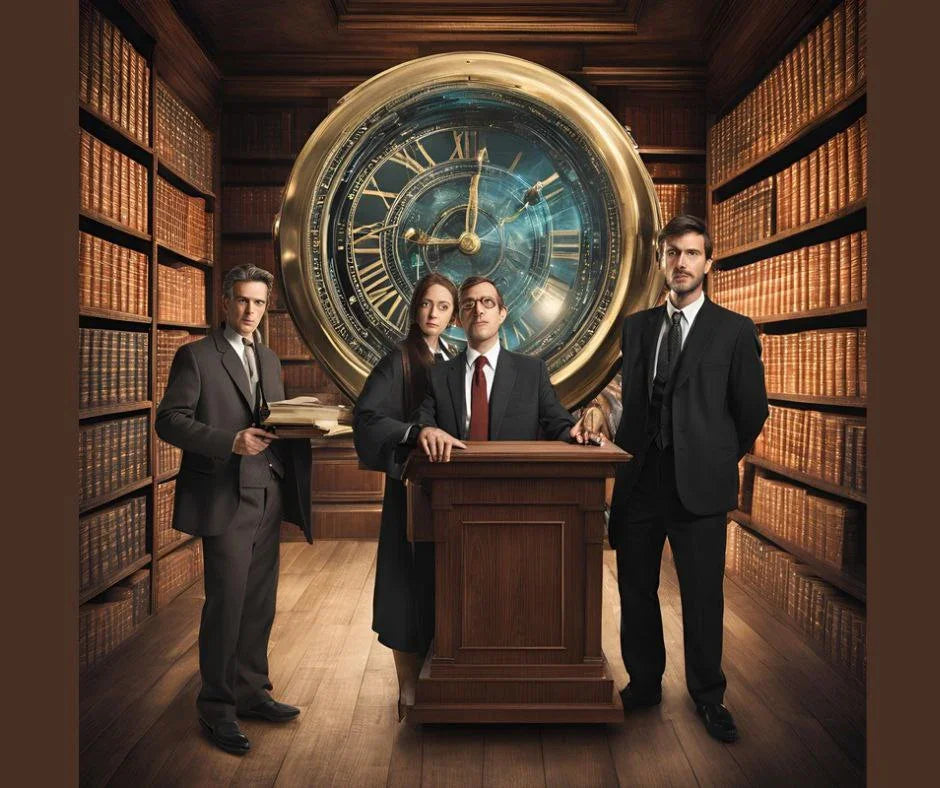
टाइम मशीन के लेंस से वकील
शेयर करना
प्राचीन मिस्र में, जो लगभग 3000-1000 ईसा पूर्व था, कानूनी मामलों की देखरेख अधिकारी करते थे जो कुछ हद तक आधुनिक न्यायाधीशों की तरह काम करते थे, लेकिन आज के वकीलों जैसे विशिष्ट कानूनी पेशे की अवधारणा मौजूद नहीं थी। कानूनी ज्ञान अक्सर शास्त्रियों के अधिकार क्षेत्र में होता था। हालाँकि, शास्त्रीय एथेंस (5वीं-4थी शताब्दी ईसा पूर्व) के समय तक, एक वकील की भूमिका आकार लेने लगी थी।
हालाँकि उस समय कोई पेशेवर वकील नहीं थे, फिर भी ऐसे सोफिस्ट ज़रूर थे जो कानूनी सलाह और भाषण कला का प्रशिक्षण देते थे। प्रसिद्ध वक्ता और दार्शनिक डेमोस्थनीज़ ऐसे ही एक उदाहरण हैं जिन्होंने कानूनी वकालत में हाथ बँटाया।
हालाँकि, अगर हम प्राचीन भारत की बात करें, तो कानूनी मामलों का निपटारा अक्सर स्थानीय शासकों या गाँव के बुजुर्गों द्वारा प्रथागत कानूनों और मनुस्मृति जैसे ग्रंथों की शिक्षाओं के आधार पर किया जाता था। आधुनिक वकीलों जैसे विशिष्ट कानूनी पेशे की अवधारणा मौजूद नहीं थी, हालाँकि विद्वान और पुजारी कभी-कभी कानूनी सलाह देते थे।
इसके विपरीत, रोमन गणराज्य और बाद में रोमन साम्राज्य में एक अधिक संरचित कानूनी पेशे का विकास हुआ। सिसरो और उल्पियन जैसे न्यायविद प्रभावशाली थे, और कानूनी वकालत एक औपचारिक पेशा बन गई जिसमें एडवोकेटस (वकील) जैसी भूमिकाएँ शामिल थीं। छठी शताब्दी ईस्वी में सम्राट जस्टिनियन के शासनकाल में संकलित कॉर्पस ज्यूरिस सिविलिस ने आधुनिक कानूनी प्रणालियों के लिए आधारभूत सिद्धांत निर्धारित किए।
आइए मध्यकालीन काल में प्रवेश करें। तो, मध्यकालीन काल में, विशेष रूप से 1066 में नॉर्मन विजय के बाद, इंग्लैंड में कानूनी पेशे ने आकार लेना शुरू किया। सामान्य कानून प्रणाली का उदय हुआ, और सार्जेंट-एट-लॉ और सॉलिसिटर जैसे कानूनी पेशेवर उभरने लगे। उन्होंने अंग्रेजी कानून और कानूनी व्यवहार के विकास में भूमिका निभाई। चर्च कानून, या कैनन कानून, ने भी मध्यकालीन यूरोप में महत्वपूर्ण भूमिका निभाई। चर्च की अदालतों के वकील, जो अक्सर कानूनी प्रशिक्षण प्राप्त पादरी होते थे, ने उस समय की कानूनी परंपराओं को आकार देने में मदद की।
हालाँकि, मध्यकाल में भारत में, विशेष रूप से दिल्ली सल्तनत और मुगल साम्राज्य के अधीन, विधि प्रशासन राज्य का एक कार्य था। न्याय व्यवस्था इस्लामी कानून से अत्यधिक प्रभावित थी, और काज़ियों (न्यायाधीशों) जैसे अधिकारियों की भूमिकाएँ कुछ-कुछ आधुनिक विधिवेत्ताओं जैसी होती थीं। वे इस्लामी न्यायशास्त्र के अनुसार विवादों का निपटारा करते थे और कानूनी फैसले सुनाते थे।
यूरोप के पुनर्जागरण काल की बात करें तो, इस काल में शास्त्रीय विधिशास्त्र ग्रंथों में रुचि का पुनरुत्थान और आधुनिक विधिशास्त्रीय विद्वत्ता का विकास हुआ। इसी काल में विश्वविद्यालयों में विधि शिक्षा का उदय और विधिक पेशे का औपचारिकीकरण भी हुआ। 17वीं और 18वीं शताब्दी तक, इंग्लैंड में बैरिस्टर और सॉलिसिटर की भूमिकाएँ और भी स्पष्ट हो गईं। बैरिस्टर उच्च न्यायालयों में वकालत करते थे, जबकि सॉलिसिटर अधिकांश कानूनी कागजी कार्रवाई और मुवक्किलों से बातचीत का काम संभालते थे।
हालाँकि, 19वीं सदी में महत्वपूर्ण सुधार और व्यावसायिकता देखी गई। संयुक्त राज्य अमेरिका में, विधि विद्यालयों और बार संघों की स्थापना के साथ कानूनी शिक्षा और व्यावसायिक मानकों को औपचारिक रूप दिया जाने लगा। कानूनी पेशा अधिक विनियमित और मानकीकृत हो गया। जबकि 20वीं सदी में बड़ी कानूनी फर्मों का उदय हुआ, पेशे में विशेषज्ञता बढ़ी और कानूनी सेवाओं का वैश्विक विस्तार हुआ। वकीलों की भूमिकाएँ अधिक विविध हो गईं, जिनमें कॉर्पोरेट कानून, पर्यावरण कानून और अंतर्राष्ट्रीय कानून शामिल हैं।
इसी तरह, अगर हम भारतीय परिदृश्य की बात करें, तो भारत में ब्रिटिश शासन की स्थापना के साथ ही न्याय व्यवस्था में बड़े पैमाने पर बदलाव आने लगे। अंग्रेजों ने अपने कानूनी सिद्धांत और संस्थाएँ स्थापित कीं। ब्रिटिश भारत में शुरुआती कानूनी पेशे में वे अधिकारी और क्लर्क शामिल थे, जिन्हें अंग्रेजी कानून का प्रशिक्षण तो मिला था, लेकिन उन्हें औपचारिक रूप से वकील के रूप में मान्यता नहीं दी गई थी।
19वीं शताब्दी में भारत में ब्रिटिश न्याय व्यवस्था की स्थापना के साथ ही कानूनी व्यवसायों का औपचारिकीकरण हुआ। विभिन्न कानूनों के अधिनियमन और विधिक संस्थाओं की स्थापना के साथ भारतीय विधिक व्यवसाय ने आकार लेना शुरू किया। प्रमुख मील के पत्थर निम्नलिखित हैं:
1. 1861 : भारतीय उच्च न्यायालय अधिनियम पारित हुआ, जिसके तहत बंबई, कलकत्ता और मद्रास में उच्च न्यायालयों की स्थापना की गई। ये न्यायालय ब्रिटिश प्रणाली के अनुरूप बनाए गए थे और भारतीय विधिक पेशे में एक महत्वपूर्ण विकास का प्रतीक थे।
2. 1865 : कलकत्ता में भारतीय बार एसोसिएशन की स्थापना हुई, जिसे बाद में बंगाल बार काउंसिल के नाम से जाना गया, जो कानूनी व्यवसायियों के लिए एक औपचारिक संगठन था।
विभिन्न प्रांतों में बार काउंसिल की स्थापना के साथ कानूनी पेशा और अधिक संगठित हो गया। उदाहरण के लिए, 1961 में एक सर्वोच्च नियामक संस्था के रूप में बार काउंसिल ऑफ इंडिया की स्थापना की गई। जैसे-जैसे भारत स्वतंत्रता की ओर बढ़ रहा था, वकीलों की भूमिका प्रमुखता प्राप्त करने लगी।
1947 में भारत को स्वतंत्रता मिलने के बाद, कानूनी पेशे का विकास नए लोकतांत्रिक और संवैधानिक ढाँचे के तहत जारी रहा। 1950 में अपनाए गए भारतीय संविधान ने न्याय व्यवस्था की संरचना निर्धारित की और मौलिक अधिकारों तथा न्यायिक समीक्षा का प्रावधान किया।
आज़ादी के बाद से क़ानूनी पेशे में उल्लेखनीय वृद्धि और विशेषज्ञता देखी गई है। 1961 के अधिवक्ता अधिनियम के तहत गठित भारतीय बार काउंसिल, क़ानूनी पेशे के नियमन और समर्थन में महत्वपूर्ण भूमिका निभाती है। देश भर में कई लॉ स्कूलों और विश्वविद्यालयों के साथ कानूनी शिक्षा प्रणाली का भी विस्तार हुआ है।
हाल के दशकों में, भारतीय विधिक पेशे की जटिलता और दायरा बढ़ा है। कॉर्पोरेट कानून, बौद्धिक संपदा कानून, पर्यावरण कानून और मानवाधिकार कानून जैसे विशिष्ट क्षेत्र मौजूद हैं। बड़ी विधि फर्मों का उदय, विधिक व्यवहार में प्रौद्योगिकी की बढ़ती भूमिका और अंतर्राष्ट्रीय विधिक व्यवहारों का बढ़ता महत्व आज इस पेशे की गतिशील प्रकृति को दर्शाता है।
हाल के दशकों में, तकनीकी प्रगति और वैश्विक गतिशीलता में बदलाव के साथ कानूनी पेशे का निरंतर विकास हुआ है। वकील अब साइबर कानून, मानवाधिकार और वैश्विक व्यापार विनियमन जैसे जटिल मुद्दों से जुड़े हुए हैं, और यह पेशा दुनिया भर में न्याय प्रशासन और कानूनी प्रणालियों का अभिन्न अंग बना हुआ है।
यह ऐतिहासिक यात्रा दर्शाती है कि किस प्रकार वकीलों की भूमिका सदियों से समाज और कानूनी प्रणालियों की बदलती जरूरतों के अनुरूप बदलती रही है।
लेखक: सुरभि प्रकृति








